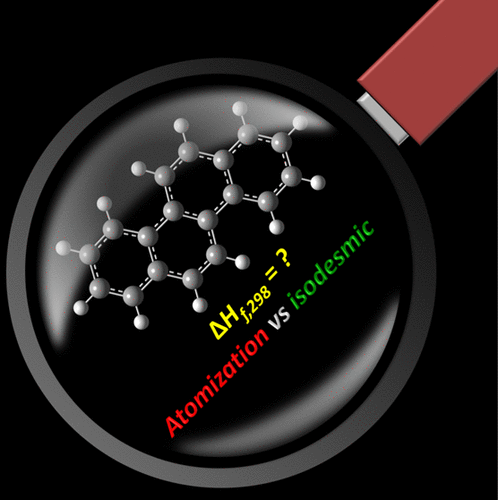当前位置:
X-MOL 学术
›
J. Chem. Eng. Data
›
论文详情
Our official English website, www.x-mol.net, welcomes your feedback! (Note: you will need to create a separate account there.)
Accurate Heats of Formation for Polycyclic Aromatic Hydrocarbons: A High-Level Ab Initio Perspective
Journal of Chemical & Engineering Data ( IF 2.6 ) Pub Date : 2021-08-18 , DOI: 10.1021/acs.jced.1c00256 Amir Karton 1 , Bun Chan 2
Journal of Chemical & Engineering Data ( IF 2.6 ) Pub Date : 2021-08-18 , DOI: 10.1021/acs.jced.1c00256 Amir Karton 1 , Bun Chan 2
Affiliation

|
Polycyclic aromatic hydrocarbons (PAHs) are key reference materials for the validation and parameterization of computationally cost-effective procedures such as density functional theory (DFT), semiempirical molecular orbital theory, and molecular mechanics. We obtain accurate heats of formation (ΔHf,298) for 20 PAHs with up to 18 carbon atoms by means of the explicitly correlated W1-F12 thermochemical procedure. The heats of formation are obtained via atomization reactions and quasi-isodesmic reactions involving CH4, C2H4, and C6H6 for which accurate experimental ΔHf,298 values are available from the active thermochemical tables (ATcT) network. We show that for large PAHs, the differences between W1-F12 heats of formation obtained from atomization and quasi-isodesmic reactions increase with the size of the system and range between 1.7 (C7H8) and 8.9 (chrysene, C18H12) kJ mol–1. This suggests that atomization reactions should be used with caution for obtaining heats of formation for medium-sized systems even when highly accurate thermochemical procedures (such as W1-F12 theory) are used. For eight PAH compounds (toluene, indene, acenaphthylene, biphenyl, diphenylmethane, anthracene, pyrene, and chrysene), our best theoretical values agree with the best experimental values to within ∼1 kJ mol–1; for six additional systems (indane, naphthalene, biphenylene, acenaphthene, phenanthrene, and m-terphenyl), the agreement between theory and experiment is good with deviations ranging between 2 and 4 kJ mol–1. However, for four systems (p-terphenyl, fluorene, pyracene, and pyracyclene), our best W1-F12 values suggest that the experimental ΔHf,298 values should be revised by significant amounts ranging from 6.5 and 24.4 kJ mol–1.
中文翻译:

多环芳烃的准确形成热:从高水平的 Ab Initio 视角
多环芳烃 (PAH) 是验证和参数化计算成本效益程序的关键参考材料,例如密度泛函理论 (DFT)、半经验分子轨道理论和分子力学。我们通过明确关联的 W1-F12 热化学程序获得了多达 18 个碳原子的 20 种多环芳烃的准确形成热 (Δ H f,298 )。生成热是通过涉及 CH 4、C 2 H 4和 C 6 H 6 的原子化反应和准等向反应获得的,其精确的实验Δ H f,298值可从活动热化学表 (ATcT) 网络中获得。我们表明,对于大 PAH,从原子化和准等向反应获得的 W1-F12 形成热之间的差异随着系统的大小而增加,范围在 1.7 (C 7 H 8 ) 和 8.9 (chrysene, C 18 H 12 ) 千焦摩尔–1. 这表明,即使使用高度准确的热化学程序(如 W1-F12 理论),也应谨慎使用雾化反应来获得中型系统的形成热。对于八种 PAH 化合物(甲苯、茚、苊、联苯、二苯甲烷、蒽、芘和芘),我们的最佳理论值与最佳实验值一致,在 ∼1 kJ mol –1以内;六个附加的系统(茚满,萘,亚联苯基,苊,菲,和米-三联苯),理论和实验之间的协议是与偏差2和千焦mol之间4测距良好-1。然而,对于四个系统 ( p-三联苯、芴、并苯和吡喃环),我们最好的 W1-F12 值表明实验 Δ H f,298值应该在 6.5 和 24.4 kJ mol –1范围内进行大量修正。
更新日期:2021-09-09
中文翻译:

多环芳烃的准确形成热:从高水平的 Ab Initio 视角
多环芳烃 (PAH) 是验证和参数化计算成本效益程序的关键参考材料,例如密度泛函理论 (DFT)、半经验分子轨道理论和分子力学。我们通过明确关联的 W1-F12 热化学程序获得了多达 18 个碳原子的 20 种多环芳烃的准确形成热 (Δ H f,298 )。生成热是通过涉及 CH 4、C 2 H 4和 C 6 H 6 的原子化反应和准等向反应获得的,其精确的实验Δ H f,298值可从活动热化学表 (ATcT) 网络中获得。我们表明,对于大 PAH,从原子化和准等向反应获得的 W1-F12 形成热之间的差异随着系统的大小而增加,范围在 1.7 (C 7 H 8 ) 和 8.9 (chrysene, C 18 H 12 ) 千焦摩尔–1. 这表明,即使使用高度准确的热化学程序(如 W1-F12 理论),也应谨慎使用雾化反应来获得中型系统的形成热。对于八种 PAH 化合物(甲苯、茚、苊、联苯、二苯甲烷、蒽、芘和芘),我们的最佳理论值与最佳实验值一致,在 ∼1 kJ mol –1以内;六个附加的系统(茚满,萘,亚联苯基,苊,菲,和米-三联苯),理论和实验之间的协议是与偏差2和千焦mol之间4测距良好-1。然而,对于四个系统 ( p-三联苯、芴、并苯和吡喃环),我们最好的 W1-F12 值表明实验 Δ H f,298值应该在 6.5 和 24.4 kJ mol –1范围内进行大量修正。



























 京公网安备 11010802027423号
京公网安备 11010802027423号